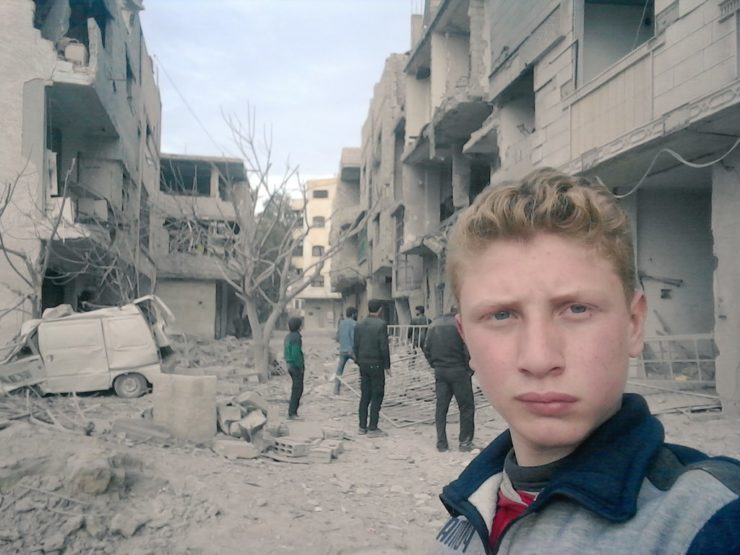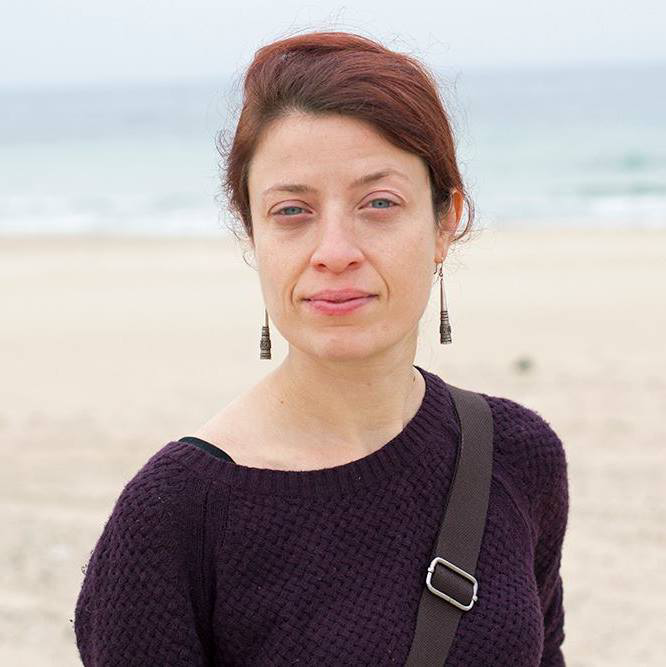
The tweet accompanying this photo read: Yesterday we were playing together in the underground shelter. Today my friend and his family were killed by a fighter plane that put his life to death. He and his family were unable to stay under the rubble of the four-storey building near my house a few hours ago.
The fog of war is especially thick in Syria, where access is nearly impossible for foreign journalists and accounts of the war often reach the outside world via social media. In the besieged Eastern Ghouta region, a blond, baby-faced teenager posting video selfies is the latest to step into the void.
Their accounts have played a key role in getting the attention of the outside world. But in the absence of professional journalists on the ground, it’s hard to piece together the whole story.
International outrage has grown in recent weeks over the Syrian government’s bombardment of Eastern Ghouta, the last major opposition-held enclave bordering the capital, Damascus.
One reason for the global attention is 15-year-old Muhammad Najem, who began posting his makeshift selfie-video reports in December. In some, he stands in front of piles of rubble or on rooftops, warplanes and smoke visible in the distance, or in a basement bomb shelter. Sometimes he appears alone, other times with groups of children and women, or, in one case, in front of a group of emergency workers loading a patient onto a van. In some of the videos, he wears the flag of the Free Syrian Army – a collection of rebel groups fighting the government of Bashar Assad – draped around his shoulders.
He sometimes speaks in Arabic, but more often in hesitant English. After each one of the brief reports, he signs off in typical war-correspondent style with the tag, “Muhammad Najem, Eastern Ghouta.”
In the first of these videos, posted on Dec. 7, 2017, Najem looks directly into the camera and introduces himself in English: “I am Muhammed Najem. I am 15 years old. I live in Eastern Ghouta. I will convey to you the events which is being committed by the Assad regime in the Eastern Ghouta through my own social media Facebook and Twitter.”
In one of the most recent videos, titled in Arabic, “The dropping of a barrel bomb from a Russian plane above my house and the occurrence of casualties,” Najem does not appear onscreen. Instead, shaky camera footage shows people scrambling through rubble amid the sound of crashes and children crying. The last few seconds of footage appear to show a wounded or lifeless child on the ground.
In the next video, Najem appears holding the camera selfie-style in front of a street full of collapsed buildings. In Arabic, he tells the audience, “Thank God, my family and I got out safely.” He added a message in English to his followers on Twitter: “I love all my friends, I’m fine so far, I and my family and I sit in an underground shelter, no water, no electricity, no food.”
Najem’s low-budget videos had gained him nearly 17,000 Twitter followers as of the beginning of March, as well as write-ups in international media, including CNN, the Guardian and Teen Vogue.
Predictably, along with the outpouring of support on Najem’s social media accounts, critics have accused him of being an impostor, aligned with terrorist groups or on the U.S. payroll.

The tweet accompanying this photo said: Dozens of Russian and Syrian planes target the eastern Ghouta with all kinds of weapons. #saveghouta
I reached out to Najem via his Twitter and Facebook accounts to request an interview. A day later, he responded on Facebook and agreed. I asked if we could do a video call, but he said the internet was too weak. Instead, we spoke (in Arabic) via voice messages and text on Messenger. Eventually, several days later, we managed a short video call over Facebook. The internet, as he had said, was too weak to manage an extended conversation, but I was able to confirm that the person I was speaking to was the boy from the videos.
He told me that he had been born and raised in Ghouta and before the war had an unremarkable life.
“I went to school and came back to the house,” he said. “That’s the most important thing I remember. Without bombing.”
Since the war began, he said, his family had been displaced several by the bombing. Two years ago, he said, his father was killed.
I asked him why he had decided to start making videos and putting them on social media.
“Before my father died, he said to me, ‘What was your crime, all of you, that you came into this world to be tormented, and in the world outside, no one is seeing you, and their children are playing and continuing with their lives?’” he said. “I carried these words in my head, and from here I started publishing, and I didn’t expect to arrive where I am today.”
I didn’t doubt the veracity of the videos, but it did seem evident to me that he’d had some help. A 15-year-old living in a war zone who has had sporadic, if any, access to school for the past several years is unlikely to be able to communicate in English with a sentence like this recent Twitter post: “Russia is a state of occupation in Syria, and the failed truce that I talked about is just to cover up its crimes in the killing of children and women in the eastern Ghouta and to emerge as a state sponsor of peace, not war.”
https://twitter.com/muhammadnajem20/status/968738687499595776
I asked him if he had made all the videos himself or if someone had helped him. He told me his sister, who had studied English at university, had helped him with the translations and that his brother also helped.
Whoever may have encouraged or helped him produce the videos, it doesn’t make the destruction surrounding this teenager any less real.
But it does highlight the difficulties of the media environment in this war. In some cases, international journalists report by communicating remotely with people they may have met in person on previous trips inside Syria. In other cases, they rely on reports from United Nations agencies, aid groups, monitoring organizations, statements put out by the various warring parties. Often, they use reports from citizen journalists, who are usually aligned with one side or the other in the conflict.
Their accounts have played a key role in getting the attention of the outside world. But in the absence of professional journalists on the ground, it’s hard to piece together the whole story.


